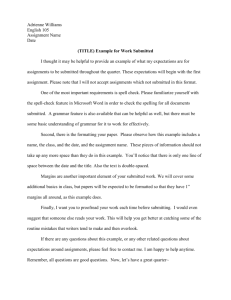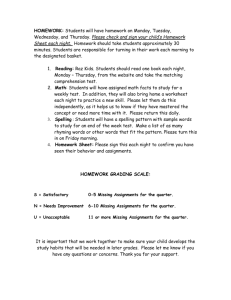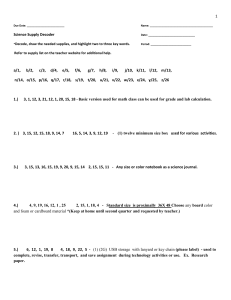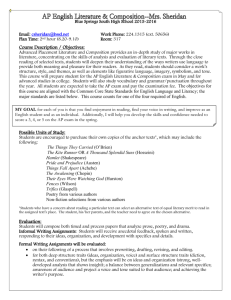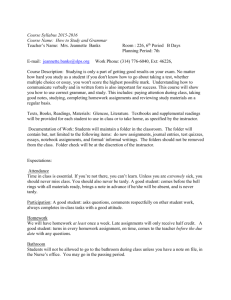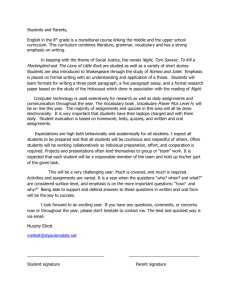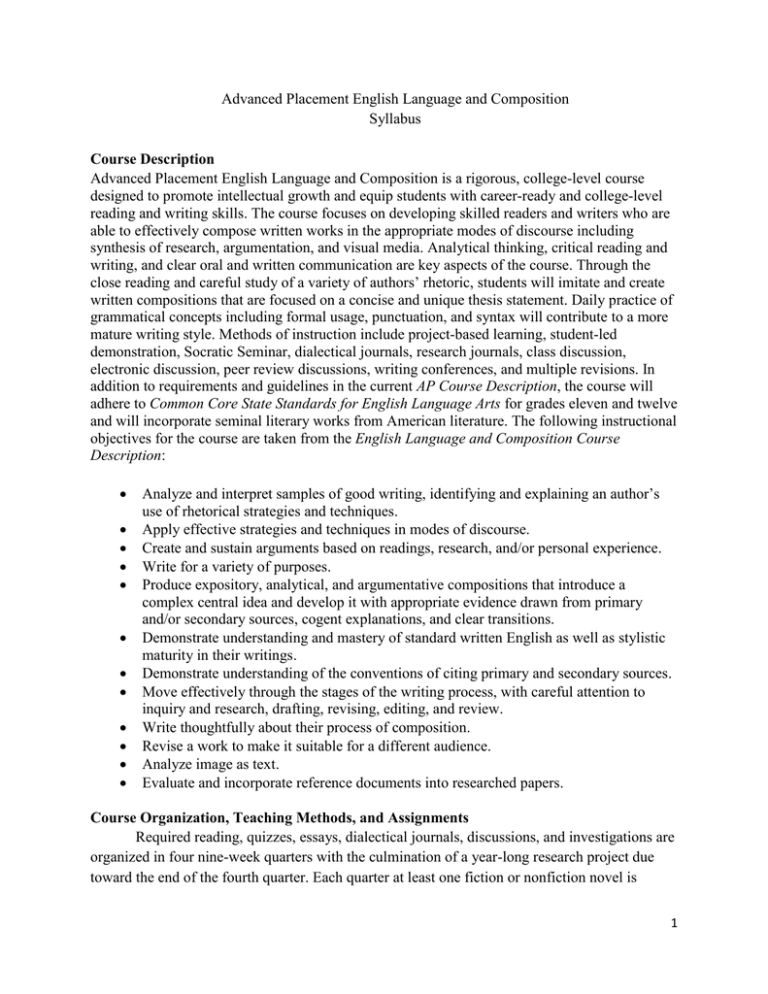
Advanced Placement English Language and Composition
Syllabus
Course Description
Advanced Placement English Language and Composition is a rigorous, college-level course
designed to promote intellectual growth and equip students with career-ready and college-level
reading and writing skills. The course focuses on developing skilled readers and writers who are
able to effectively compose written works in the appropriate modes of discourse including
synthesis of research, argumentation, and visual media. Analytical thinking, critical reading and
writing, and clear oral and written communication are key aspects of the course. Through the
close reading and careful study of a variety of authors’ rhetoric, students will imitate and create
written compositions that are focused on a concise and unique thesis statement. Daily practice of
grammatical concepts including formal usage, punctuation, and syntax will contribute to a more
mature writing style. Methods of instruction include project-based learning, student-led
demonstration, Socratic Seminar, dialectical journals, research journals, class discussion,
electronic discussion, peer review discussions, writing conferences, and multiple revisions. In
addition to requirements and guidelines in the current AP Course Description, the course will
adhere to Common Core State Standards for English Language Arts for grades eleven and twelve
and will incorporate seminal literary works from American literature. The following instructional
objectives for the course are taken from the English Language and Composition Course
Description:
Analyze and interpret samples of good writing, identifying and explaining an author’s
use of rhetorical strategies and techniques.
Apply effective strategies and techniques in modes of discourse.
Create and sustain arguments based on readings, research, and/or personal experience.
Write for a variety of purposes.
Produce expository, analytical, and argumentative compositions that introduce a
complex central idea and develop it with appropriate evidence drawn from primary
and/or secondary sources, cogent explanations, and clear transitions.
Demonstrate understanding and mastery of standard written English as well as stylistic
maturity in their writings.
Demonstrate understanding of the conventions of citing primary and secondary sources.
Move effectively through the stages of the writing process, with careful attention to
inquiry and research, drafting, revising, editing, and review.
Write thoughtfully about their process of composition.
Revise a work to make it suitable for a different audience.
Analyze image as text.
Evaluate and incorporate reference documents into researched papers.
Course Organization, Teaching Methods, and Assignments
Required reading, quizzes, essays, dialectical journals, discussions, and investigations are
organized in four nine-week quarters with the culmination of a year-long research project due
toward the end of the fourth quarter. Each quarter at least one fiction or nonfiction novel is
1
required out-of-class reading along with short works of nonfiction. Students will analyze texts
using the rhetorical triangle, rhetorical appeals, and logical fallacies when appropriate. As the
class is comprised of juniors, and the district has selected the junior year to focus on American
literature, most readings for the course are selected from American literature. Consequently,
several of the readings coincide with assigned reading for U.S. History. Students will maintain
double-entry dialectical journals to record their observations and analyses of texts, record
reflections, and track their development as a critical reader and writer. The dialectical journal is a
forum for formal and informal thought and inquiry and is an integral tool for all types of class
discussion. To support stylistic and rhetorical analysis, students will use the following taskappropriate strategies:
SOAPS (speaker, occasion, audience, purpose, subject)
SOAPSTone (speaker, occasion, audience, purpose, subject, tone)
DIDLS (diction, imagery, details, language, syntax)
OPTIC (nonfiction: overview, parts, title, interrelationships, conclusion)
SIFT (symbol, images, figures of speech, tone, theme)
TWIST (prompt analysis and thesis statements: tone, word choice, imagery and detail,
style, theme)
SMELL (speeches: sender-receiver relationship, message, emotional strategies, logical
strategies, language)
TP-CASTT (poetry: title, paraphrase, connotation, attitude, shifts, title, theme)
To help facilitate voluminous reading requirements each quarter, to develop students’
interpersonal skills, and to encourage collaboration and personal accountability, students will
form study groups of three to six members. Each student is required to read the assigned novel,
but the group will divide equally the shorter readings. When sharing a piece with the group,
students compose a précis of the assigned reading and share an analytical entry text from their
dialectical journal. To add variety, I periodically pull students out of their study group for a
jigsaw reading and also require the study groups to rotate members each quarter.
Grading Guidelines and Testing Procedures
Students complete formative and summative assessments administered throughout the
fall and spring semesters. Multiple-choice and short answer quizzes and exams are given at
regular intervals to assess students’ knowledge of vocabulary and literary concepts. Question
formats are multiple-choice, short answer, and some true/false. In addition to paper and pencil
formats, quizzes are also delivered via various electronic platforms such as Edmodo, Schoology,
and Socrative.com. Students receive formative and descriptive feedback on assessments and are
encouraged to rewrite essays; however, quizzes may not be retaken. Expository, analytic, and
argumentative essays are graded using rubrics describing content, style, usage, and mechanics as
well as rubrics used to score essays for the AP exam. Students will conduct research on a
selected topic and synthesize the research into a formal document incorporating MLA citations.
2
The research project is due toward the end of the fourth quarter, but students conduct research
throughout the year creating annotated bibliographies in research journals. Dialectical and
research journals allow students to reflect on their processes. Release tests of former AP exams
form the basis for AP exam practice along with items found at MHPracticePlus.com. To receive
enhanced credit for the APLAC course, students must take the College Board exam designed for
the course. Grades will be assigned using the following designations:
Writing assignments and essay tests: 30%
Class work, homework, and quizzes: 20%
Socratic Seminars: 20%
Dialectical Journal: 20%
Research: 10%
During the fourth quarter, the research paper will count as 25% of the overall grade, and the 20%
categories will reduce to 15%.
A (90-100%) Descriptors
Exceeds standards
Engaged fully in all assignments
Engages independently in reflective and inferential thinking
Contributes regularly to discussions with insightful comments
Poses questions to encourage discussion
Treats classmates with respect and honors their work and comments
Submits excellent assignments on time, including make-up work
Submits assignments that are properly documented and contain no plagiarism
B (80-89%) Descriptors
Meets or exceeds most standards
Engaged competently in most assignments
Engages with prompting in reflective and inferential thinking
Contributes regularly to discussions with insightful comments
Poses questions to encourage discussion
Treats classmates with respect and honors their work and comments
Submits some high-quality assignments late, including make-up work
Submits assignments that are properly documented and contain no plagiarism
C (70-79%) Descriptors
Meets most standards
Engaged tacitly in most assignments
Engages reluctantly in reflective and inferential thinking
Contributes infrequently to discussion
Poses questions and comments that lack depth
Treats classmates with respect and honors their work and comments
Submits some good-quality assignments late, including make-up work
Submits assignments that are properly documented and contain no plagiarism
3
D (60-69%) Descriptors
Does not meet or refuses to meet several standards
Engaged minimally in most assignments
Engages unwillingly or refuses to engage in reflective and inferential thinking
Contributes infrequently to discussion, contributes off-topic comments, or fails to
contribute at all
Rarely or never poses questions
May make inappropriate or disrespectful comments to classmates
Habitually submits low-quality assignments late, including make-up work
Submits assignments that are properly documented and contain no plagiarism
F (59% and Below) Descriptors
Does not meet or refuses to meet several standards
Engaged minimally or refuses to engage in most assignments
Engages unwillingly or refuses to engage in reflective and inferential thinking
Contributes infrequently to discussion, contributes off-topic comments, or fails to
contribute at all
Rarely or never poses questions
May make inappropriate or disrespectful comments to classmates
Habitually submits unacceptable-quality assignments late, including make-up work
Submits assignments that are improperly documented and contain plagiarism
First Quarter: What is freedom? Why do people seek freedom? What is liberty? Why do
people seek liberty?
Each week except Week 1 consists of the following: Daily Grammar Practice, literary terms,
vocabulary words, assigned readings, dialectical journal, and research. Essay assignments are
due every two to three weeks. Dialectical journals are due weekly. Directed research is due as
assigned.
Quarter one begins with introductions, icebreakers, expectations (including acceptable use of
technology and mobile devices), procedures, syllabus, student-parent letters, MLA citation
guidelines, mandated pretests (including a sample AP exam), weekly schedule, classroom
environment, gathering supplies, and setting up binders and journals. Students will gather
information about rhetoric, rhetorical appeals, the rhetorical triangle, and strategies for literary
analysis. The second week of the quarter begins with a review the discovery of America and
transitions into assigned reading and writing.
Readings:
Allegory of the Cave by Plato
4
Iroquois Confederacy (http://www.britannica.com/EBchecked/topic/294660/Iroquois-) and
Iroquois Constitution (http://tuscaroras.com/pages/history/iroquois_constitution_1.html
Excerpts from John Smith’s Journals
(http://www.smithtrail.net/captain-john-smith/smiths-journals/)
Excerpts from Of Plymouth Plantation by William Bradford
(http://mith.umd.edu/eada/html/display.php?docs=bradford_history.xml)
Mary Rowlandson’s Captivity Narrative
Excerpts from William Byrd’s Diary
Excerpts from The History of the Dividing Line by William Byrd
The Crucible by Arthur Miller; read and view
The Scarlet Letter by Nathaniel Hawthorne
Sinners in the Hands of an Angry God by Jonathan Edwards
Salvation by Langston Hughes
No Name Woman by Maxine Hong Kingston
The Minister’s Black Veil by Nathaniel Hawthorne
Declaration of Sentiments and Resolutions by Elizabeth Cady Stanton
Ain’t I a Woman? by Sojourner Truth
Readings on the Social Contract Theory (http://www.iep.utm.edu/soc-cont/)
Common Sense by Thomas Paine
The Crisis by Thomas Paine
The Declaration of Independence by Thomas Jefferson
Letter to John Adams by Abigail Adams
Wit and Wisdom from Poor Richard’s Almanack by Benjamin Franklin
Research:
How does early American literature treat the concepts of freedom and liberty?
Assignments:
Daily Grammar Practice Weeks 1-8
Vocabulary Unit I
Literary Terms
Narrative: Write a narrative that illustrates the concept of either freedom or liberty or both.
14 Dialectical journal entries including 3 entries on visual media
2 annotated bibliographies with at least two sources for each topic
3 Precis
3 Socratic circle discussions
3 Literary analysis essays with three peer reviews
2 Writing conferences with instructor
5
Quizzes on readings, syntax, literary terms, and vocabulary
Essay: Compare and contrast the ideas of freedom of and liberty. Reference at least two works
you have read to support your thesis.
Second Quarter: What is justice? Why do people seek justice?
Readings:
Bury My Heart at Wounded Knee by Dee Brown
The Gettysburg Address by Abraham Lincoln
Abraham Lincoln’s letter to Mrs. Bixby (http://www.civil-war.net/pages/mrs_bixby_letter.asp)
When Lilacs Last in the Dooryard Bloomed by Walt Whitman
O Captain, My Captain by Walt Whitman
Civil War letters, diaries, and battle reports (http://www.civilwar.net/searchlinks.asp?searchlinks=Letters and Diaries)
A Worn Path by Eudora Welty
The Outcasts of Poker Flat by Bret Harte
The Celebrated Jumping Frog of Calaveras County by Mark Twain
The War Prayer by Mark Twain
The Lowest Animal by Mark Twain
I Will Fight No More Forever by Chief Joseph
Selected poems by Emily Dickinson
Excerpt from Narrative of the Life of Frederick Douglass by Frederick Douglass
Disobedience to Civil Government by Henry David Thoreau
Where I Lived and What I Lived For by Henry David Thoreau
Research:
How have the philosophical concepts of realism, transcendentalism, American romanticism, and
Darwinism impacted American culture?
Assignments:
Daily Grammar Practice Weeks 9-15
Vocabulary Unit II
Literary Terms
Narrative: Compose a local color narrative.
14 Dialectical journal entries including 3 entries on visual media
3 Socratic circle discussions
3 Precis
3 argumentative essays with 3 peer reviews
2 annotated bibliographies with at least two sources for each topic
2 Writing conferences with instructor
Quizzes on readings, syntax, literary terms, and vocabulary
6
Essay: Consider cause/effect relationships connected with justice. What causes justice? What are
the effects of justice? Reference at least two works you have read during the second quarter to
support your thesis.
Third Quarter: What is isolationism? Why do people seek to isolate themselves? What is
imperialism? How does imperialism manifest itself in an individual’s psyche? What is
modernism? How did modernism develop? What are the causes of economic diversity in a
society and what are its effects?
Readings:
Devil in the White City by Erik Larson
Book Review
(http://www.nytimes.com/2003/02/10/books/books-of-the-times-add-a-serial-murdererto-1893-chicago-s-opulent-overkill.html)
Timeline at http://public.wsu.edu/~campbelld/index.html (view images)
World’s Columbian Exposition Review
http://www.encyclopedia.chicagohistory.org/pages/1386.html
Great Chicago Fire at www.greatchicagofire.org
Triangle Shirtwaist Factory Fire
www.ilr.cornell.edu/trianglefire
www.osha.gov/oas/trianglefactoryfire.html
www.pbs.org/wgbh/americanexperience/films/triangle/player (viewing)
http://en.wikipedia.org/wiki/Triangle_shirtwaist_factory_fire
The Pit and the Pendulum by Edgar Allan Poe
The Philosophy of Composition by Edgar Allan Poe
(http://www.eapoe.org/works/essays/philcomp.htm)
The Great Gatsby by F. Scott Fitzgerald; read novel and view recent movie
The Yellow Wallpaper by Charlotte Perkins Gillman
A Room of One’s Own by Virginia Wolf
A Jury of Her Peers by Susan Glaspell
Once More to the Lake by E. B. White
Shooting an Elephant by George Orwell
The Wasteland by T. S. Elliot
Angela’s Ashes by Frank McCourt
A Modest Proposal by Jonathan Swift
Learning to Read and Write by Frederick Douglass
Learning to Read by Malcom X
The Joy of Reading and Writing: Superman and Me by Sherman Alexi
On Compassion by Barbara Lazear Ascher
7
Regarding the Pain of Others by Susan Sontag
On Dumpster Diving by Lars Eighner
Selected poems by Robert Frost such as Birches, Stopping by the Woods on a Snowy Evening,
Home Burial, and After Apple Picking
Research:
How has the advent of industrialism and technology shaped current American culture? How have
entitlement programs shaped the current economic condition in America?
Assignments:
Daily Grammar Practice Weeks 16-23
Vocabulary Unit III
Literary Terms
Narrative: Compose a narrative illustrating human struggle.
14 Dialectical journal entries including 3 entries on visual media
3 Socratic circle discussions
3 Precis
2 argumentative essays with 2 peer reviews
1 synthesis essay with 1 peer review
2 annotated bibliographies with at least two sources for each topic
Research conference with instructor
Quizzes on readings, syntax, literary terms, and vocabulary
Essay: Describe the economic diversity in your current culture. What are the effects of this
diversity? OR Describe the connections among isolationism, imperialism, and economic
diversity along with causes and effects of their interrelatedness.
Fourth Quarter: How do authors use literature as a platform for promoting personal
agendas? How do authors use literature to spawn social and political reform?
Readings:
In Cold Blood by Truman Capote
The Imp of the Perverse by Edgar Allan Poe (http://poestories.com/read/imp)
The Death of the Moth by Virginia Wolf
On Being a Cripple by Nancy Mairs
On Morality by Joan Didion
The Ways We Lie by Stephanie Ericsson
Seeing by Annie Dillard
The Things They Carried by Tim O’Brien
Letter from Birmingham Jail by Martin Luther King, Jr.
Just Walk on By: Black Men and Public Space by Brent Staples
How it Feels to be Colored Me by Zora Neal Hurston
8
The Obligation to Endure by Rachel Carson
Mother Tongue by Amy Tan
Shooting Dad by Sarah Vowell
Research:
How do authors use literature to spawn social and political reform?
Assignments:
Daily Grammar Practice Weeks 24-30
Vocabulary Unit IV
Literary Terms
Narrative: Compose a narrative illustrating your view of human rights.
14 Dialectical journal entries including 3 entries on visual media
3 Socratic circle discussions
3 Precis
1 analysis essay with 1 peer review
1 argument essay with 1 peer review
Research conference with instructor
Quizzes on readings, syntax, literary terms, and vocabulary
Research Project
Required Materials for Students
Beers, Kyleen, Odell, Lee. Elements of Literature, Fifth Course.Austin: Holt, Rinehart, and
Winston, 2005. Print.
Burnette, Dawn. Daily Grammar Practice, Grade 12, Second Edition. Blairsville, Georgia: DGP
Publishing, 2003. Print.
Capote, Truman. In Cold Blood. New York: Random House, 1965. Print.
Cohen, Samuel. 50 Essays: A Portable Anthology. 3rd. Boston: Bedford/St. Martin's, 2011. Print.
Larson, Erik. The Devil in the White City. New York: Vintage, 2004. Print.
McCourt, Frank. Angela's Ashes. 1st. New York: Scribner, 1999. Print.
Odell, Lee, Richard Vacca, Renee Hobbs, and John E. Warriner. Elements of Language, Sixth
Course. Austin: Holt, Rinehart, and Winston, 2005. Print.
Helpful References
1. OWL Purdue Online Writing Lab. http://owl.english.purdue.edu/owl/resource/677/01/
2. AP Central. http://apcentral.collegeboard.com/apc/Controller.jpf?navid=ap-apcentral
3. Precis Writing http://grammar.about.com/od/pq/g/precisterm.htm
9
Teacher Resources
AP Vertical Teams Guide for English, Second Edition. The College Board Pre-AP. 2002. Print.
Copeland, Matt. Socratic Circles: Fostering Critical Thinking in Middle and High Schools.
Portland,Maine: Stenhouse Publishers, 2005. Print.
Great American Short Stories. Austin: Holt, Rinehart, and Winston, 1991. Print.
Murphy, Barbara L., Ranking, Estelle M. 5 Steps to a 5: AP English Language, 2012-2013. New
York: McGraw-Hill, 2012. Print.
Roskelly, Hephzibah, and David A. Jolliffe. Everyday Use: Rhetoric at Work in Reading and
Writing. 2nd. New York: Pearson Longman, Print.
Shea, Renee, Lawrence Scanlon, and Robin Aufses. The Language of Composition: Reading,
Writing, Rhetoric. 2nd. Boston: Bedford/St. Martin's, 2013. Print.
Images:
http://www.cagle.com/teacher for political cartoons
http://images.google.com for a variety of visual media
10
References
“Achieving Equity.” College Board. College Board. Web. 4 Apr 2013.
<http://professionals.collegeboard.com/k-12/assessment/ap/equity>.
"English Language and Composition Course Description." AP Central. College Board. Web. 4
Apr 2013. <http://apcentral.collegeboard.com/apc/public/repository/ap-english-coursedescription.pdf>.
11
Appendix A: Literary Terms
From 5 Steps to a 5 by Barbara L. Murphy and Estelle M. Rankin, 2012-2013 Edition, McGrawHill
Abstract
Ad Hominem
Allegory
Alliteration
Analogy
Anecdote
Antecedent
Antithesis
Argument
Attitude
Balance
Cacophony
Character
Colloquial
Comic Relief
Conflict
Connective Tissue
Connotation
Cumulative Sentence
Deduction
Denotation
Diction
Didactic
Ellipsis
Epigraph
Ethos
Euphemism
Euphony
Exposition
Extended Metaphor
Figurative Language
Flashback
Form
Hyperbole
Image
Imagery
Induction
Inference
Invective
Irony
Logic
Logical fallacy
Logos
Metaphor
Metonymy
Monologue
Motif
Narrator
Onomatopoeia
Oxymoron
Pacing
Parable
Parody
Pathos
Pedantic
Periodic Sentence
Personification
Persuasion
Plot
Point of View
Polemic
Pun
Reductio ad Absurdum
Rhetoric
Rhetorical Question
Sarcasm
Satire
Setting
Simile
Stage Directions
Stanza
Structure
Style
Summary
Syllogism
Symbol
Synecdoche
Syntax
Synthesis
Theme
Thesis
Tone
Transition
Understatement
Voice
.
12
Appendix B: Tone Vocabulary
From valenciacollege.edu/east/academicsuccess/eap/documents/tonewords.pdf
Positive Tone/Attitude Words
Amiable
Consoling
Amused
Content
Appreciative
Dreamy
Authoritative
Ecstatic
Benevolent
Elated
Brave
Elevated
Calm
Encouraging
Cheerful
Energetic
Cheery
Enthusiastic
Compassionate
Excited
Complimentary
Exuberant
Confident
Fanciful
Friendly
Happy
Hopeful
Impassioned
Jovial
Joyful
Jubilant
Lighthearted
Loving
Optimistic
Passionate
Peaceful
Playful
Pleasant
Proud
Relaxed
Reverent
Romantic
Soothing
Surprised
Sweet
Sympathetic
Vibrant
Whimsical
Negative Tone/Attitude Words
Accusing
Choleric
Aggravated
Coarse
Agitated
Cold
Angry
Condemnatory
Apathetic
Condescending
Arrogant
Contradictory
Artificial
Critical
Audacious
Desperate
Belligerent
Disappointed
Bitter
Disgruntled
Boring
Disgusted
Brash
Disinterested
Childish
Facetious
Furious
Harsh
Haughty
Hateful
Hurtful
Indignant
Inflammatory
Insulting
Irritated
Manipulative
Obnoxious
Outraged
Passive
Quarrelsome
Shameful
Smooth
Snooty
Superficial
Surly
Testy
Threatening
Tired
Uninterested
Wrathful
Humor-Irony-Sarcasm Tone/Attitude Words
Amused
Droll
Mock-heroic
Bantering
Facetious
Mocking
Bitter
Flippant
Mock-serious
Caustic
Giddy
Patronizing
Comical
Humorous
Pompous
Condescending
Insolent
Quizzical
Contemptuous
Ironic
Ribald
Critical
Joking
Sad
Sardonic
Satiric
Scornful
Sharp
Silly
Taunting
Teasing
Wry
13
Disdainful
Malicious
Sarcastic
Sorrow-Fear-Worry Tone/Attitude Words
Aggravated
Embarrassed
Morose
Agitated
Fearful
Mournful
Anxious
Foreboding
Nervous
Apologetic
Gloomy
Numb
Apprehensive
Grave
Ominous
Concerned
Hollow
Paranoid
Confused
Hopeless
Pessimistic
Dejected
Horrific
Pitiful
Depressed
Horror
Poignant
Despairing
Melancholy
Regretful
Disturbed
Miserable
Remorseful
Neutral Tone/Attitude Words
Admonitory
Dramatic
Allusive
Earnest
Apathetic
Expectant
Authoritative
Factual
Baffled
Fervent
Callous
Formal
Candid
Forthright
Ceremonial
Frivolous
Clinical
Haughty
Consoling
Histrionic
Contemplative
Humble
Conventional
Incredulous
Detached
Informative
Didactic
Inquisitive
Disbelieving
Instructive
Intimae
Judgmental
Learned
Loud
Lyrical
Matter-of-fact
Meditative
Nostalgic
Objective
Obsequious
Patriotic
Persuasive
Pleading
Pretentious
Provocative
Resigned
Sad
Serious
Sober
Solemn
Somber
Staid
Upset
Questioning
Reflective
Reminiscent
Resigned
Restrained
Seductive
Sentimental
Serious
Shocking
Sincere
Unemotional
Urgent
Vexed
Wistful
Zealous
14
15


